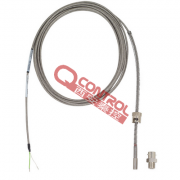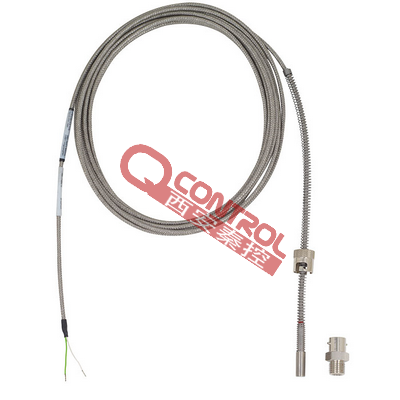产品分类
- wika压力表
- wika远传压力表
- wika压力变送器
- wika压力开关
- wika双金属温度计
- wika远传温度计
- wika热电阻/热电偶
- wika温度开关/数显表
- wika温度变送器
- wika液位计/液位变送器
- wika液位开关
- wika光电开关
- wika附件
- WIKA差压开关
产品推荐
没有相关数据

德国wika电缆式热电偶TC53 威卡
- 品牌:
- 型号:
- 产地:
- 分类:wika热电阻/热电偶
- 业务电话: 029-89390083 86696828

威卡TC53卡口式热电偶温度计 德国wika电缆式热电偶TC53
分度号:Types K, J, E, N, T (单支或者双支)
TC53卡扣式热电偶的主要参数
Sensor
Thermocouple per IEC 60584-1 or ASTM E230
Types K, J, E, N, T (single or dual thermocouple)
Sensor types
Type Operating temperatures of the thermocouple
IEC 60584-1 ASTM E230
Class 2 Class 1 Standard Special
K -40 ... +1,200 °C -40 ... +1,000 °C 0 ... 1,260 °C
J -40 ... +750 °C -40 ... +750 °C 0 ... 760 °C
E -40 ... +900 °C -40 ... +800 °C 0 ... 870 °C
N -40 ... +1,200 °C -40 ... +1,000 °C 0 ... 1,260 °C
T -40 ... +350 °C 0 ... 370 °C
The table shows the temperature ranges listed in therespective standards, in which the tolerance values (classaccuracies) are valid.
The actual application range of these thermometers is limitedby the permissible maximum ambient temperature for thecable insulation. For applications of temperatures above400 °C we recommend sheathed thermocouples.Listed models are available both as single or dualthermocouples. The thermocouple will be delivered withan ungrounded measuring point, unless explicitly specified otherwise.
For detailed specifications for thermocouples, seeIEC 60584-1 or ASTM E230 and Technical information
Tolerance value
For the tolerance value of thermocouples, a cold junctiontemperature of 0 °C has been taken as the basis.
Probe
Design: Rigid tube
Material: Stainless steel
Diameter: 6 mm or 8 mm
Length: 10 mm
other versions on request
For temperature measurement in a solid body, the diameter of the bore into which the sensor should be inserted must be no more than 1 mm larger than the sensor diameter。
Maximum working temperatures
The maximum working temperature for these thermometers is limited by different parameters.
If the temperature to be measured inside the sensor measuring range is higher than the permissible temperature at the connection cable, the connector or the transition point, the metallic part of the sensor (mineral-insulated cable) must be long enough to place the critical components outside of the hot zone. The lowest of the maximum working temperatures of process connection, connection line, cable
transition or connector must be observed here.
■ Sensor (thermocouple)
The temperature ranges indicated on page 4 refer to the operating range of the thermocouple. These measuring
ranges depend on the selected thermocouple and the selected accuracy class.
Operation outside the measuring range defined for the given thermocouple type and class can result in a damage to the thermocouple.
■ Connection cable and single wires At any point on the connection cable, the maximum temperature that may be attained is that for which the connection cable is specified. The sensor itself (see page 5) can potentially withstand higher temperatures.
For the common connection lines the following maximum operating temperatures apply:
PVC -20 … +100 °C
Silicone -50 … +200 °C
PTFE -50 … +250 °C
Fibreglass -50 … +400 °C
Since, in the tubular design variant, an isolated cable is also fitted within the metal probe, the operating limits of the connection cable apply.
■ Transition from the metal part of the thermometer to the connection cable
The temperature at the transition is further limited by the use of a potted sealing compound.
Temperature range of the potting compound: -40 ... +150 °C Option: 250 °C
(other variants on request)
Temperature range of the special low-temperature version:-60 ... +120 °C 1)
1) only available with selected approvals
■ Connector (option)
With the option of a coupler connector fitted the maximum
permissible temperature range is:
Lemosa: -55 ... +250 °C
Binder: -40 ... +85 °C
Transition
The junction between the metal part of the probe and the connecting cable or wire is either rolled or potted, depending on the design. This area should not be immersed within the process and must not be bent. Compression fittings should not be attached to the transition. The type and dimensions of the transition depend largely on the combination between input leads and metal probe and the sealing requirements.
The dimension T describes the length of the transition.
IP ingress protection
Bayonet thermocouples can be delivered with up to IP65 (dependent on cable sheath material and number of wires).
With a special design, IP67 is also possible on request.Connection leads with a glass-fibre sheath cannot be combined with an explosion-proof version
Cable
Wire material: Compensating cable depending on type of sensor (stranded wire)
Wire cross-section: approx. 0.22 mm²
Number of wires: According to the number of sensors
Abschirmung: Optional
Wire ends: Blank
Connecting cable
There are various insulating materials available to match different environmental conditions. The free ends of the
cable are made up ready for connection, or can be fitted with connectors or sockets as optional extras.

威卡TC53温度计的描述
探头
这些电缆式热电偶的特点是一种卡扣式的探头连接。TC53系列热电偶可以安装在没有热槽的钻孔中,例如进入机器部件。
电缆
卡口式热电偶的电缆具有多种绝缘材料可供选择,能满足特定环境条件的应用要求。电缆末端已预制好,可直接连接,当然客户也可根据需要选配插头或将电缆连接到现场外壳上。
TC53订货须知:
型号/卡口型/防爆型/传感器***型/探头直径和长度/探头型/卡口型/盖材料/测量元件/温度范围/护套、原材料/连接电缆、护套/引线端版本/
证书/选项
分度号:Types K, J, E, N, T (单支或者双支)
TC53卡扣式热电偶的主要参数
Sensor
Thermocouple per IEC 60584-1 or ASTM E230
Types K, J, E, N, T (single or dual thermocouple)
Sensor types
Type Operating temperatures of the thermocouple
IEC 60584-1 ASTM E230
Class 2 Class 1 Standard Special
K -40 ... +1,200 °C -40 ... +1,000 °C 0 ... 1,260 °C
J -40 ... +750 °C -40 ... +750 °C 0 ... 760 °C
E -40 ... +900 °C -40 ... +800 °C 0 ... 870 °C
N -40 ... +1,200 °C -40 ... +1,000 °C 0 ... 1,260 °C
T -40 ... +350 °C 0 ... 370 °C
The table shows the temperature ranges listed in therespective standards, in which the tolerance values (classaccuracies) are valid.
The actual application range of these thermometers is limitedby the permissible maximum ambient temperature for thecable insulation. For applications of temperatures above400 °C we recommend sheathed thermocouples.Listed models are available both as single or dualthermocouples. The thermocouple will be delivered withan ungrounded measuring point, unless explicitly specified otherwise.
For detailed specifications for thermocouples, seeIEC 60584-1 or ASTM E230 and Technical information
Tolerance value
For the tolerance value of thermocouples, a cold junctiontemperature of 0 °C has been taken as the basis.
Probe
Design: Rigid tube
Material: Stainless steel
Diameter: 6 mm or 8 mm
Length: 10 mm
other versions on request
For temperature measurement in a solid body, the diameter of the bore into which the sensor should be inserted must be no more than 1 mm larger than the sensor diameter。
Maximum working temperatures
The maximum working temperature for these thermometers is limited by different parameters.
If the temperature to be measured inside the sensor measuring range is higher than the permissible temperature at the connection cable, the connector or the transition point, the metallic part of the sensor (mineral-insulated cable) must be long enough to place the critical components outside of the hot zone. The lowest of the maximum working temperatures of process connection, connection line, cable
transition or connector must be observed here.
■ Sensor (thermocouple)
The temperature ranges indicated on page 4 refer to the operating range of the thermocouple. These measuring
ranges depend on the selected thermocouple and the selected accuracy class.
Operation outside the measuring range defined for the given thermocouple type and class can result in a damage to the thermocouple.
■ Connection cable and single wires At any point on the connection cable, the maximum temperature that may be attained is that for which the connection cable is specified. The sensor itself (see page 5) can potentially withstand higher temperatures.
For the common connection lines the following maximum operating temperatures apply:
PVC -20 … +100 °C
Silicone -50 … +200 °C
PTFE -50 … +250 °C
Fibreglass -50 … +400 °C
Since, in the tubular design variant, an isolated cable is also fitted within the metal probe, the operating limits of the connection cable apply.
■ Transition from the metal part of the thermometer to the connection cable
The temperature at the transition is further limited by the use of a potted sealing compound.
Temperature range of the potting compound: -40 ... +150 °C Option: 250 °C
(other variants on request)
Temperature range of the special low-temperature version:-60 ... +120 °C 1)
1) only available with selected approvals
■ Connector (option)
With the option of a coupler connector fitted the maximum
permissible temperature range is:
Lemosa: -55 ... +250 °C
Binder: -40 ... +85 °C
Transition
The junction between the metal part of the probe and the connecting cable or wire is either rolled or potted, depending on the design. This area should not be immersed within the process and must not be bent. Compression fittings should not be attached to the transition. The type and dimensions of the transition depend largely on the combination between input leads and metal probe and the sealing requirements.
The dimension T describes the length of the transition.
IP ingress protection
Bayonet thermocouples can be delivered with up to IP65 (dependent on cable sheath material and number of wires).
With a special design, IP67 is also possible on request.Connection leads with a glass-fibre sheath cannot be combined with an explosion-proof version
Cable
Wire material: Compensating cable depending on type of sensor (stranded wire)
Wire cross-section: approx. 0.22 mm²
Number of wires: According to the number of sensors
Abschirmung: Optional
Wire ends: Blank
Connecting cable
There are various insulating materials available to match different environmental conditions. The free ends of the
cable are made up ready for connection, or can be fitted with connectors or sockets as optional extras.

威卡TC53温度计的描述
探头
这些电缆式热电偶的特点是一种卡扣式的探头连接。TC53系列热电偶可以安装在没有热槽的钻孔中,例如进入机器部件。
电缆
卡口式热电偶的电缆具有多种绝缘材料可供选择,能满足特定环境条件的应用要求。电缆末端已预制好,可直接连接,当然客户也可根据需要选配插头或将电缆连接到现场外壳上。
TC53订货须知:
型号/卡口型/防爆型/传感器***型/探头直径和长度/探头型/卡口型/盖材料/测量元件/温度范围/护套、原材料/连接电缆、护套/引线端版本/
证书/选项
